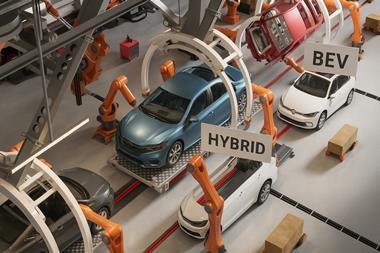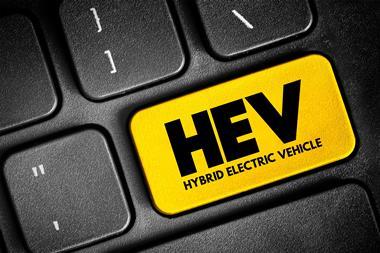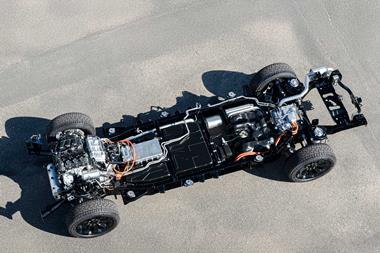Fuel-cell electric vehicles have lagged behind other EVs, but upcoming models could help that to change
 Everyone involved in hydrogen fuel cell development is probably tired of hearing the same old joke: large-scale adoption is a decade away, and always will be. David Hart, a director at sustainable energy consultancy E4Tech and co-author of its annual report, Fuel Cell Industry Review, thinks the witticism may soon lose its sting. He is confident that fuel-cell electric vehicles (FCEVs) have finally reached the cusp of commercial viability.
Everyone involved in hydrogen fuel cell development is probably tired of hearing the same old joke: large-scale adoption is a decade away, and always will be. David Hart, a director at sustainable energy consultancy E4Tech and co-author of its annual report, Fuel Cell Industry Review, thinks the witticism may soon lose its sting. He is confident that fuel-cell electric vehicles (FCEVs) have finally reached the cusp of commercial viability.
“Fuel cells have suffered for a long time,” Hart explains to AMS. “It has partly been a lack of understanding about just how complex the technology is. So announcements turned out to be optimistic and people tried to launch products before they realised there were mechanisms for degradation and failure and other issues that they simply hadn’t managed to control.”
As a result, the chasm separating fuel cell R&D from production has proven more difficult to cross than expected. “We’ve seen a lot more research, a lot more field testing, a lot more materials understanding and development,” Hart adds. “Technologies and products being launched today are a lot more sensible than those launched five or ten years ago.”

Low production, high pricesE4Tech’s report covers a spectrum of industrial applications, but the automotive sector will be key, predicts Hart. “If the automotive companies really get going, that has a huge impact on everybody else,” he says. “They’re always the ones that do high volume, cost squeezing and have super-high requirements for qualification and quality.”
Several carmakers have already put FCEVs on the market, but production remains low and prices high. Isotta Cerri, general manager for advanced material research at Toyota, suggests that FCEVs are drawing level with gasoline hybrids in terms of capability, but expense remains the biggest hurdle.
High costs result from many factors, including the need for a platinum catalyst. “The catalyst is the most important item, but of course other components and production costs are relevant,” Cerri tells AMS. “We believe we can still reduce the cost by improving current technology, and by mass production.”
Toyota has not revealed how much it costs to make the heart of its Mirai FCEV, but a recent estimate prepared for the US Department of Energy priced its fuel cell system at $21,200, built at an annual volume of 1,000 units. Hydrogen storage, motors, inverters, control systems and every other component of a modern sedan cost extra.
Hyundai’s Nexo, unveiled at the CES show in January, replaces the ix35 Fuel Cell from March this year. Designed for hydrogen power from the outset, Nexo uses three identical 52-litre cylinders installed at the rear – a simplification over the mismatched 40- and 104-litre tanks squeezed into the ix35’s modified structure. Nexo carries a maximum of 6.3kg of hydrogen, compared with 5.6kg for the ix35.
The new car’s fuel cell is also more economical than before, managing 59 miles per kilo of hydrogen versus 47 for the ix35, extending range between fill-ups from 265 to 370 miles. Hyundai says Nexo achieves 60% efficiency, can start from a -29°C chill, and offers longevity comparable to a petrol car.
Hyundai, for example, describes its $74,000 ix35/Tucson Fuel Cell as mass-produced but shipped only 500 units to Europe and another 150 to the US. Honda’s Clarity Fuel Cell, offered for lease in Southern California and sold in Japan for ¥7.7m ($73,000), also has volumes measured in hundreds.
Modest forecasts are also part of the plan for the Mercedes-Benz GLC F-Cell, a new hydrogen SUV that is currently a pre-production design. The vehicle is unusual in combining fuel cell technology with a mains-charged battery, creating a plug-in hybrid FCEV. According to Christian Mohrdieck, Daimler’s director of fuel cells, the model will enter the market in 2018. “It’s designed to test the market,” he states. “We would like to see how the car is used and rated by real customers. We’ll concentrate on those regions where there is good hydrogen infrastructure, such as Germany.”
All FCEVs are electrically propelled, so fitting a hybrid battery to supplement the fuel cell is standard practice. A fuel cell operates by combining hydrogen with oxygen from the air to produce electricity, with water and heat as by-products. As with gasoline hybrids, a battery is helpful to capture and store energy from braking, which can be redeployed to drive the FCEV for short distances, power the system during start-up, and assist during rapid fluctuations in demand.
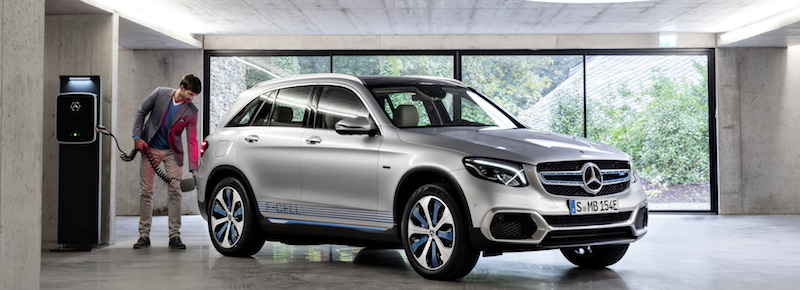 The GLC F-Cell is a new hydrogen SUV from Mercedes-Benz
The GLC F-Cell is a new hydrogen SUV from Mercedes-BenzThe battery fitted to Hyundai’s ix35 Fuel Cell is comparable to that of a Toyota Prius, storing 0.95kWh. By contrast, Daimler has given its GLC a battery ten times as big, with an operating store of 9.3kWh. A full charge is enough for 49km on battery power alone under NEDC conditions. The result is a more flexible vehicle, better able to cope with the current scarcity of hydrogen filling stations. The whole of the UK, for example, boasts just 12 hydrogen filling stations, only half of which can dispense hydrogen at the 700-bar pressure needed for a full tank.
The GLC F-Cell might complete many daily journeys without using any hydrogen at all. In turn, the rapid refuelling that is the primary benefit of FCEVs versus battery EVs will be available for longer journeys, assuming the route is near a hydrogen station. The GLC F-Cell’s range between fill-ups is 437km with a full tank storing 4.4kg of hydrogen. “We don’t like the A or B approach, we think it should be A and B,” Mohrdieck emphasises.
Like Hart, Mohrdieck has worked with fuel cells for decades and believes that FCEVs are finally poised for viability. “We’re just at the beginning,” he says. “I think in the second half of the next decade, after 2025, we’ll see significant use of fuel cell vehicles. But I don’t mean we’ll see a sudden explosion, it will probably still be a single-digit percentage of the global market.”
He predicts an adoption rate similar to that of hybrid cars after the Prius arrived in 1997. Even Toyota concedes that hybrid cars made up only 3% of global sales in 2017, though the share is growing. “We’ve had 20 years of hybrids, which had no need for any kind of special infrastructure,” Mohrdieck observes. “So I think we should be realistic.”
Strength in numbersModest production volumes can help establish standard components, which will drive down costs. “In the beginning of any technology, R&D is focused on coming up with our own solution,” Mohrdieck notes. “But we need standardisation to roll out at volume. It’s in the interests of our customers. They don’t care what kind of tank valve we’re using, just as they don’t care what make of turbocharger we use. That’s not where we sharpen our competitive edge.”
He adds that further work is still needed to cut the size and number of components and reduce the need for expensive materials: “If we compare the GLC with our earlier B-Class fuel cell vehicle, the platinum requirement has been reduced by 90%. That’s a huge leap, but we still need further cost reduction.”
Process improvements are also needed to trim assembly costs. “Manufacturing of the fuel cell stack in the GLC is not highly automated, but it’s not hand-made either,” says Mohrdieck. “The process is semi-automated; for example, stacking of cells is done by robots. Other parts of the assembly are harder to automate, but if we wanted to go to much higher volumes tomorrow, we could do it with the GLC’s fuel cell design.”
In the US, General Motors (GM) and Honda have joined forces to commercialise fuel cell production. Last year, the two companies formed a 50-50 joint venture called Fuel Cell System Manufacturing (FCSM) with the aim of producing fuel cells from 2020 at GM’s Brownstown facility in Michigan, which currently builds batteries for the Chevrolet Volt. The partnership will run until at least 2026 and probably longer, says Suheb Haq, president of the joint venture from the GM side.
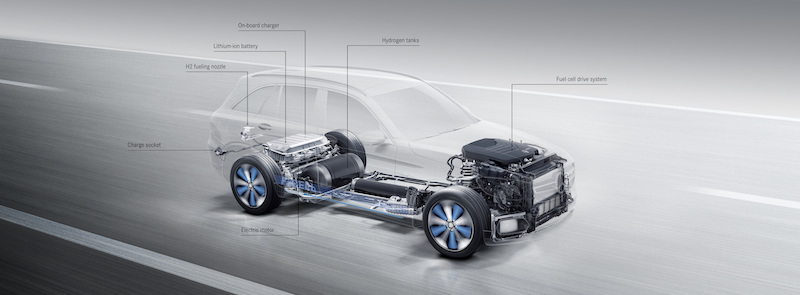 The Mercedes-Benz GLC F-Cell, due to enter the market in 2018, includes an unusual combination of fuel-cell technology and mains-charged battery
The Mercedes-Benz GLC F-Cell, due to enter the market in 2018, includes an unusual combination of fuel-cell technology and mains-charged batteryThe two OEMs will design their own FCEVs using a common fuel cell stack, though some vehicles may not be road cars. “We’ve looked at potential applications for land, sea and air,” notes Haq. He adds that military customers are interested in FCEVs due to their quiet operation, low thermal signature and rapid refuelling. Two recent FCEV prototypes from GM are a militarised Chevrolet Colorado ZH2 pick-up truck and an autonomous flatbed called SURUS (Silent Utility Rover Universal Superstructure).
Haq describes the GM-Honda joint venture as a “strength and intensity multiplier”, allowing the two companies to pool intellectual property and human expertise as they focus on cost reduction and process refinement. “There’s a 24-hour development clock,” Haq says, noting that teams in Japan and the US can collaborate in opposite time zones. There will also be economies of scale. “You’ve got the volumes of two companies, you’re able to share the investment, share the operating cost,” Haq confirms.
Besides solo or joint achievements, the prospects for FCEVs also depend heavily on governments and their policies for encouraging zero emissions cars and the proliferation of refuelling stations. Battery EVs attract plenty of attention, with supporters trumpeting their well-to-wheel efficiency compared with FCEVs, but hydrogen remains a contender.
 In 2016, GM revealed a fuel cell variant of the Chevrolet Colorado, which has undergone tests with the US Army. The OEM is also working with Honda
In 2016, GM revealed a fuel cell variant of the Chevrolet Colorado, which has undergone tests with the US Army. The OEM is also working with HondaAs Hart observes, Japan imports most of its energy and would like to diversify its dependence. Hydrogen is much easier to import from varied sources than electricity. Similarly, the Chinese government has included FCEVs in its New Energy Vehicle scheme, which offers generous incentives and subsidies.
“China is influencing demand,” Hart says. “They don’t have suitable indigenous technology, so they’re pulling into the frame all the people who’ve developed fuel cells over the last decade – Ballard and Hydrogenics and others have agreements with Chinese auto manufacturers and suppliers. It’s had a really significant impact on the sector.”
Chinese firms are also keen to poach foreign expertise. “They’re absolutely desperate,” Hart says. “Partner companies are keeping them at arm’s length – providing finished fuel cells but none of the sub-technology. If Chinese companies can entice people over with impressive salaries, they will.”
The Chinese government may see fuel cells as a chance to steal a march over international rivals, backing what could become a key future technology. As Hart speculates: “A lot of small fuel cell companies have struggled for cash over recent years. If the Chinese can simply acquire them, they could end up supplying a global industry.”

































